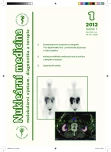Neuroendocrine tumors
Authors:
Hana Křížová
Authors‘ workplace:
Klinika nukleární medicíny 3. LF UK a FN Královské Vinohrady, Praha
Published in:
NuklMed 2012;1:3-4
Category:
Editorial
Overview
Neuroendocrine tumors (NET) are relatively rare tumors characterized by their ability to produce and release different peptide hormones and bioctive amines, the effect of which influenced the clinical picture of the disease. Functional imaging with different radiopharmaceuticals (in the Czech republic available I-123/I-131 MIBG, In-111 or Tc-99m labeled analogs of somatostatin and F-18 FDG) is used besides conventional imaging methods in their diagnosis.
Key words:
neuroendocrine tumors, scintigraphy
Sources
1. Intenzo Ch. et al: Scintigraphic Imaging of Body Neuroendocrine Tumors. RadioGraphics 2007;27:1355-1369
2. Binderup T. et al: Functional Imaging of Neuroendocrine Tumors: A Head-to-Head Comparison of Somatostatin Receptor Scintigraphy, 123I-MIBG Scintigraphy, and 18F-FDG PET. J Nucl Med 2010; 5:704-712
3. Rufini V. et al: Imaging of neuroendocrine tumous. Semin Nucl Med 2006;36:228-247
4. Kaltsas G A et al: Treatment of advanced neuroendocrine tumours with radiolabelled somatostatin analogues. Endocr Relat Cancer December 1 2005;12:683-699
Labels
Nuclear medicine Radiodiagnostics RadiotherapyArticle was published in
Nuclear Medicine

2012 Issue 1
Most read in this issue
- Somatostatin receptor scintigraphy - 99mTc-EDDA/HYNIC-TOC first clinical experience in the Czech Republic
- Neuroendocrine tumors
- Stress tests in nuclear cardiology
- Quality of stress tests performed for myocardial perfusion scintigraphy
